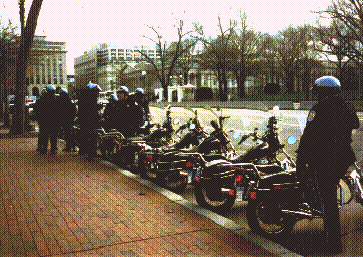
Peace Park
Under Siege
by Miriam Olsen
If the National Park Service has its way, the Lafayette Peace Park community across the street from the White House in Washington, D.C., may become one of the uncounted casualties of the Persian Gulf War.
Since its inception in 1981 by William Thomas and Concepcion Picciotto, the Lafayette Peace Park has maintained a 24-hour a day presence, perhaps the longest such continuous peace vigil in the United States. Since 1983, the community has been the target of a myriad of National Park Service regulations designed solely for the purpose of removing what many consider to be a troublesome "eyesore" from the White House environs. Regulations put into effect throughout the decade include strict definitions of what constitutes "camping", limits on the size of signs, and the now-famous "60 decibels"regulation. Soon these will be joined by proposed new rules, including one limiting personal possessions in the park to no more than Three cubic feet.
The Minnesota Peace Drum and a group of nine Minnesotans, five of them Native Americans, spent the days and nights of January 13-17 in Lafayette Park Two of the group's members returned with the drum five weeks later. after reports of
greatly increased arrests and harassment by Park Police reached them.
Two women, Bev Nii-Anderson of Hackensack. MN (a member of the Leech Lake Pillager band) and I returned to Minnesota on March 2 after four days in Washington. D.C. They report that the Peace Park community is now the object of constant surveillance and intimidation by the Park Police. Enforcement of NPS
regulations is arbitrary and selective: Peace Park residents are kicked by officers every half hour during the night, and if they are asleep- are arrested for "camping," while homeless who sleep throughout the park are allowed to rest undisturbed Upon release from jail, personal property (signs, blankets, musical instruments, even eyeglasses) is not being returned to protesters. If they move more than three feet away from their property (even to go to the bathroom) Park Police enter the gate in the newly constructed iron fence to confiscate it.
The drums of Lafayette park are now silenced every evening at 7 p.m. by a cadre of Park Police officers. Thursday evening, February 28,sixteen officers came through the gate to usher the Minnesota Peace Drum out of the park. When the police were asked if the drum could be set down and not beaten so the Minnesotans could remain with the vigil. their reply was: "If you sit that drum down, it will be confiscated and you will be arrested."
Arrests of this small protest community, committed to maintaining, at any cost to themselves, a nonviolent witness for peace and disarmament, began to escalate when the fighting began in the Persian Gulf and it continues, even though the war is "over." 'As of February 18. there had been 121 arrests of Peace Park residents since the onset of the war. Total arrests as of press time approach 200.
Originally known as the "President's Park" after its purchase for $469 in 1791. Lafayette Park was separated from the White House lawn by Thomas Jefferson, who decided it for the people's use. Visitors from across the nation and around
the world include Lafayette Park and its protest community on their stops at the White.House. They chat, ask questions, and gather leaflets from Peace Park residents.'They request permission to pose for photographs in front of the no-longer-
allowed signs. "How wonderful it is for you Americans," a Korean visitor exclaimed to a member of the Minnesota group during those days in January. "How wonderful that you are allowed to oppose the President's policies right across the street from his house...."
Miriam Olsen is a peace activist and Northern Sun member who lives and writes in Browerville. MN. She may be contacted at RR 3 #136. Browerville. MN 56452, phone (612) 594-2454. Bev Nii-Anderson can be reached at P.O. Box 353, Hackensack, MN, 56452, phone (218) 675-5176.
Concepcion Information List | Conchita Personal Story
Photographs | The President's Neighbor
